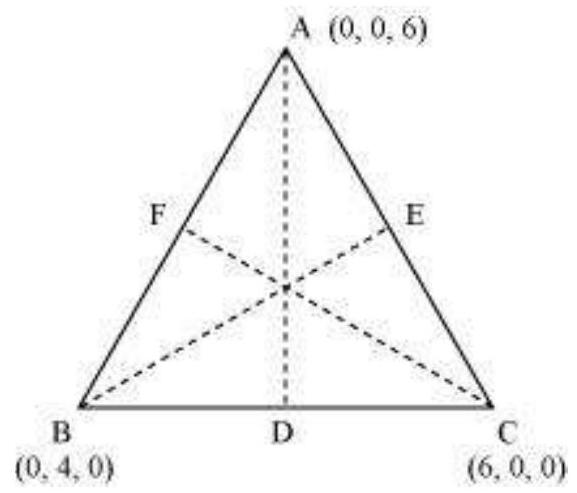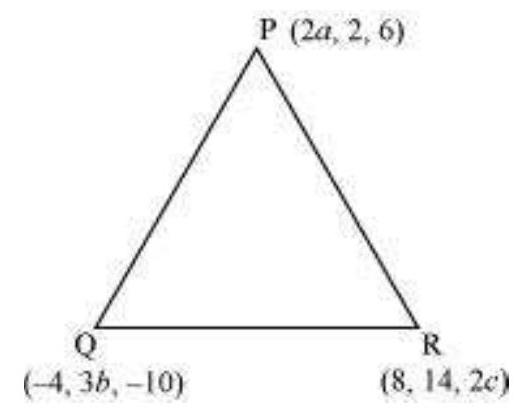Chapter 11 Introduction To Three Dimensional Geometry Miscellaneous Exercise
Miscellaneous Exercise on Chapter 11
1. Three vertices of a parallelogram $ABCD$ are $A\left(3,-1,2\right), \ B \left(1,2,-4\right)$ and $C\left(-1,1,2\right)$. Find the coordinates of the fourth vertex.
Show Answer
Answer :
The three vertices of a parallelogram $A B C D$ are given as $ A\left(3, - 1, 2 \right), B\left(1,2,- 4\right),$ and $C \left(-1, 1, 2\right).$ Let the coordinates of the fourth vertex be $D\left(x, y, z\right)$.

We know that the diagonals of a parallelogram bisect each other.
Therefore, in parallelogram $A B C D, A C$ and $B D$ bisect each other.
$\therefore \ \ $ Mid-point of $A C=$ Mid-point of $B D$
$\Rightarrow \ \ \left(\dfrac{3-1}{2}, \dfrac{-1+1}{2}, \dfrac{2+2}{2}\right)=\left(\dfrac{x+1}{2}, \dfrac{y+2}{2}, \dfrac{z-4}{2}\right)$
$\Rightarrow \ \ \left(1,0,2\right)=\left(\dfrac{x+1}{2}, \dfrac{y+2}{2}, \dfrac{z-4}{2}\right)$
$\Rightarrow \ \ \dfrac{x+1}{2}=1, \dfrac{y+2}{2}=0$, and $\dfrac{z-4}{2}=2$
$\Rightarrow \ \ x=1, y=- 2$ , and $z=8$
Thus, the coordinates of the fourth vertex are $\left(1, -2, 8\right).$
2. Find the lengths of the medians of the triangle with vertices $A\left(0,0,6\right), B\left(0,4,0\right)$ and $\left(6,0,0\right)$.
Show Answer
Answer :
Let $A D, B E$, and $C F$ be the medians of the given triangle $A B C$.

Since $A D$ is the median, $D$ is the mid-point of $B C$.
$\therefore \ \ $ Coordinates of point $D=\left(\dfrac{0+6}{2}, \dfrac{4+0}{2}, \dfrac{0+0}{2}\right)=\left(3,2,0\right)$
$AD=\sqrt{\left(0-3\right)^{2}+\left(0-2\right)^{2}+\left(6-0\right)^{2}}=\sqrt{9+4+36}=\sqrt{49}=7$
Since $BE$ is the median, $E$ is the mid-point of $AC$.
$\therefore \ \ $ Coordinates of point $E=\left(\dfrac{0+6}{2}, \dfrac{0+0}{2}, \dfrac{6+0}{2}\right)=\left(3,0,3\right)$
$BE=\sqrt{\left(3-0\right)^{2}+\left(0-4\right)^{2}+\left(3-0\right)^{2}}=\sqrt{9+16+9}=\sqrt{34}$
Since $CF$ is the median, $F$ is the mid-point of $AB$.
$\therefore \ \ $ Coordinates of point $F=\left(\dfrac{0+0}{2}, \dfrac{0+4}{2}, \dfrac{6+0}{2}\right)=\left(0,2,3\right)$
Length of $C F=\sqrt{\left(6-0\right)^{2}+\left(0-2\right)^{2}+\left(0-3\right)^{2}}=\sqrt{36+4+9}=\sqrt{49}=7$
Thus, the lengths of the medians of $\triangle A B C$ are $7, \sqrt{34}$, and $7$
3. If the origin is the centroid of the triangle $PQR$ with vertices $P\left(2 a, 2,6\right)$, $Q\left(-4,3 b,-10\right)$ and $R\left(8,14,2 c\right)$, then find the values of $a, b$ and $c$.
Show Answer
Answer :

It is known that the coordinates of the centroid of the triangle, whose vertices are
$\left(x_1, y_1, z_1\right),\left(x_2, y_2, z_2\right)$ and $\left(x_3, y_3, z_3\right)$, are $\left(\dfrac{x_1+x_2+x_3}{3}, \dfrac{y_1+y_2+y_3}{3}, \dfrac{z_1+z_2+z_3}{3}\right)$
Therefore, coordinates of the centroid of
$\Delta PQR=\left(\dfrac{2 a-4+8}{3}, \dfrac{2+3 b+14}{3}, \dfrac{6-10+2 c}{3}\right)=\left(\dfrac{2 a+4}{3}, \dfrac{3 b+16}{3}, \dfrac{2 c-4}{3}\right)$
It is given that origin is the centroid of $\triangle P Q R$.
$\therefore \ \ \left(0,0,0\right)=\left(\dfrac{2 a+4}{3}, \dfrac{3 b+16}{3}, \dfrac{2 c-4}{3}\right)$
$\Rightarrow \ \ \dfrac{2 a+4}{3}=0, \dfrac{3 b+16}{3}=0$ and $\dfrac{2 c-4}{3}=0$
$\Rightarrow \ \ a=-2, b=-\dfrac{16}{3}$ and $c=2$
Thus, the respective values of $a, b$, and $c$ are
$ -2,-\dfrac{16}{3}, \text{ and } 2 $
4. If $A$ and $B$ be the points $\left(3,4,5\right)$ and $\left(-1,3,-7\right),$ respectively, find the equation of the set of points $P$ such that $PA^{2}+PB^{2}=k^{2}$, where $k$ is a constant.
Show Answer
Answer :
The coordinates of points A and B are given as $\left(3,4,5\right)$ and $(-1,3,-7)$ respectively.
Let the coordinates of point $P$ be $\left(x, y, z\right)$.
On using distance formula, we obtain
$ \begin{aligned} PA^{2} & =\left(x-3\right)^{2}+\left(y-4\right)^{2}+\left(z-5\right)^{2} \\ \\ & =x^{2}+9-6 x+y^{2}+16-8 y+z^{2}+25-10 z \\ \\ & =x^{2}-6 x+y^{2}-8 y+z^{2}-10 z+50 \\ \\ PB^{2} & =\left(x+1\right)^{2}+\left(y-3\right)^{2}+\left(z+7\right)^{2} \\ \\ & =x^{2}+2 x+y^{2}-6 y+z^{2}+14 z+59 \end{aligned} $
Now, if $PA^{2}+PB^{2}=k^{2}$,
then,
$ \begin{aligned} & \left(x^{2}-6 x+y^{2}-8 y+z^{2}-10 z+50\right)+\left(x^{2}+2 x+y^{2}-6 y+z^{2}+14 z+59\right)=k^{2} \\ \\ & \Rightarrow \ \ 2 x^{2}+2 y^{2}+2 z^{2}-4 x-14 y+4 z+109=k^{2} \\ \\ & \Rightarrow \ \ 2\left(x^{2}+y^{2}+z^{2}-2 x-7 y+2 z\right)=k^{2}-109 \\ \\ & \Rightarrow \ \ x^{2}+y^{2}+z^{2}-2 x-7 y+2 z=\dfrac{k^{2}-109}{2} \\ \\ & \qquad x^{2}+y^{2}+z^{2}-2 x-7 y+2 z=\dfrac{k^{2}-109}{2} . \end{aligned} $





